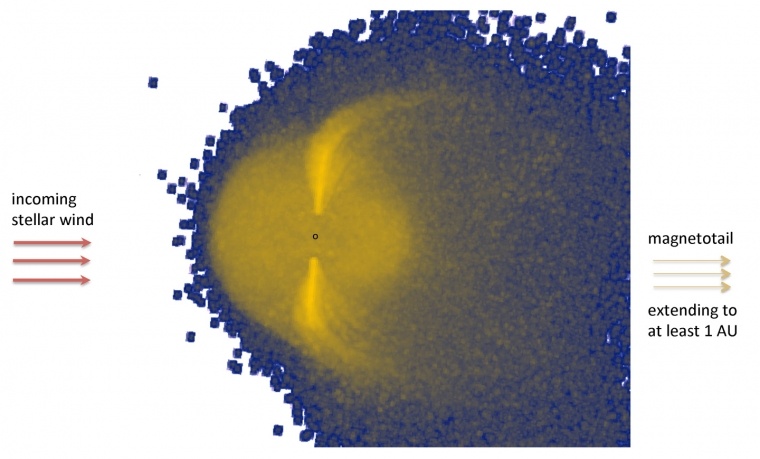A team of astronomers from The University of Arizona’s Lunar and Planetary Laboratory, NASA’s Jet Propulsion Laboratory, Harvard, the European Space Agency as well as French, German and Spanish institutions have published a first-ever discovery in Nature Astronomy. The first exoplanet, a world that lies outside of our solar system, with its own detectable magnetic field. To say that the astronomers were floored is an understatement. And even more amazingly, this discovery wasn’t made by the brand, spanking new James Webb Space Telescope (JWST) launched in December, but rather by its’ aging but still extremely potent predecessor, the Hubble Space Telescope. It’s clear that the Hubble isn’t quite finished taking us to Universal school just yet.
The magnetic field of the Earth, or magnetosphere forms the crucial protective barrier that spares the surface of our world from the ravages of solar wind, the same particle and radiation blasts that stripped away the atmosphere of Mars billions of years ago (as theorized), when the smaller world’s core cooled and the field collapsed.
As Universe Today explained,
“Using Hubble data, the team observed HAT-P-11b, a Neptune-sized exoplanet that orbits a K-type (orange dwarf) star located 123 light-years from Earth. This is what is known as the Transit Method (aka. Transit Spectroscopy), where periodic dips in a star’s brightness indicate that a planet or other celestial body is passing in front of it (or “transiting”). In addition to being the most popular and effective means of exoplanet detection, this method can also reveal spectra from exoplanet atmospheres.”
Hubble’s Discovery of a Magnetic Footprint
The big ‘ah-hah moment’ came when the team observed HAT-P-11 through six transits.The Hubble it had turned out picked up carbon ions, enveloping the planet. The most likely interpretation of these readings is that the charged particles are traveling along a magnetic field surrounding HAT-P-11.Its essentially the footprint of a life-saving magnetosphere.

It was further discovered that the carbon ions not only wrap around the world, but extend out into a ‘magnetotail’ at least one au (distance from the Earth to The Sun) out into space in the opposite direction of the sun’s stellar winds.
Gilda Ballester, an adjunct research professor at the University of Arizona and a co-author on the paper, is also a principal investigator of a Hubble program that observed HAT-P-11b. As she explained in a recent LPL press release:
“This is the first time the signature of an exoplanet’s magnetic field has been directly detected on a planet outside our solar system. A strong magnetic field on a planet like Earth can protect its atmosphere and surface from direct bombardment of the energetic particles that make up the solar wind. These processes heavily affect the evolution of life on a planet like Earth because the magnetic field shelters organisms from these energetic particles.”
“Just like Earth’s magnetic field and its immediate space environment interact with the impinging solar wind, which consists of charged particles traveling at about 900,000 mph, there are interactions between HAT-P-11b’s magnetic field and its immediate space environment with the solar wind from its host star, and those are very complex.”
Don’t Get Comfortable Though
Unfortunately, HAT-P-11 is definitely not within the habitable zone of its’ star. The reason we’re detecting charged particles is that the atmosphere is literally boiling away at the top layers, plus its atmosphere is oddly non-metallic, and it’s basically a ‘mini-Neptune’. A runty gas giant if you will.
“Although HAT-P-11 b’s mass is only 8% of that of Jupiter, we think the exoplanet more resembles a mini-Jupiter than a Neptune,” Ballester said. “The atmospheric composition we see on HAT-P-11b suggests that further work needs to be done to refine current theories of how certain exoplanets form in general.”
Very likely we won’t be finding life on HAT-P-11 any time soon, but the methods we’ve learned can pave the way for finding many more worlds with Magnetic fields that match or exceed the Earth’s and can safeguard future homes for the human race, or the home of things we can’t even imagine.






